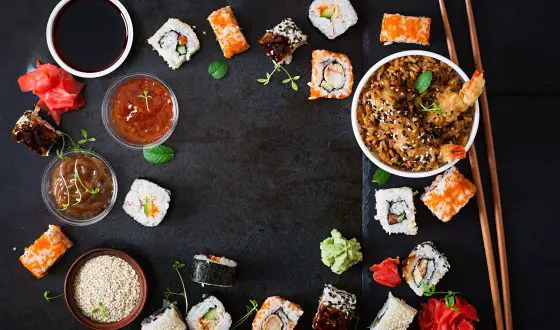6 Types of Tuna for Sushi: Everything You Need to Know
It is one of the most well-known fish, especially at this time of year, and there are several varieties that reach their season. There are several varieties of tuna, however, it is said that Japan only sells a select number. If you are a sushi eater, have you ever wondered what types of tuna for sushi are commonly used? Let’s find out through the article below.
Basic knowledge of Sushi
When you hear the phrase sushi, you probably instantly picture Japan. One of the most popular Japanese meals in the world is this. The primary component is glutinous rice. Because it has been soaked in vinegar or fermented with it, sticky rice has a sour flavor. So, sushi actually translates to “sour.”
Sushi is typically served with a variety of items, including eggs, vegetables, raw fish, and seafood. It is often chilled. Plain soy sauce, mustard for seasoning, and pickled ginger are the most popular pairings with sushi.
If you only consider the surface level, it could seem pretty straightforward and simple to carry out. In reality, learning how to create sushi step-by-step takes years of intensive training for Japanese chefs.
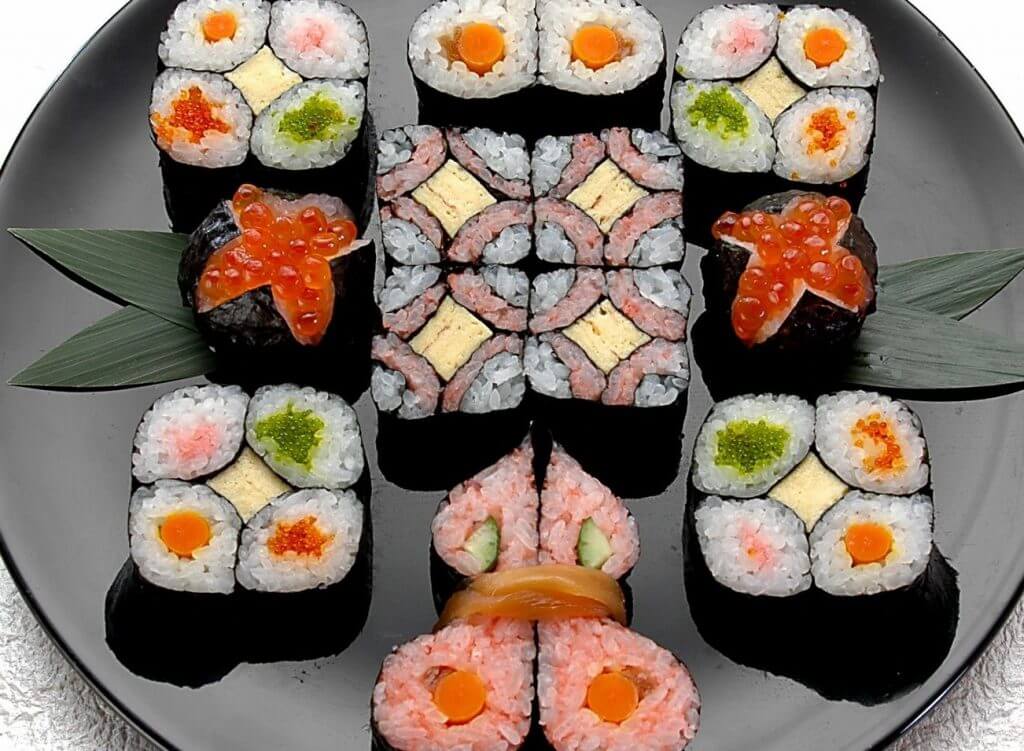
Sushi is typically served with a variety of items, including eggs, vegetables, raw fish, and seafood. It is often chilled. (Source: Internet)
Sushi was previously only available to see and order from Japanese eateries. Sushi, however, is already readily accessible at any neighborhood supermarket or convenience shop and may even be produced at home.
Since its inception and evolution up until the present, sushi has been separated into two widely consumed market-available styles: traditional Japanese sushi style and Western sushi style.
In the table below, we have learned about the characteristics of sushi styles:
| Sushi of styles | Traditional Japanese sushi style | Western sushi style |
| Ingredients used |
|
|
| Characteristic |
|
|
| Eating Manners |
|
|
6 selections of types of tuna for sushi caught in Japan
1. Bluefin tuna
Bluefin tuna, also known as original maguro, is the king of the tuna world and the most popular type.
It is caught in the North Pacific and Atlantic Oceans, including the waters near Japan, and is characterized by a shiny black body and a large body of nearly 3m.
Bluefin tuna is a high-class fish, and a single wild tuna is worth more than 1 million yen. Because it is often traded at a high price, it is sometimes called the “Black Sea Diamond”.
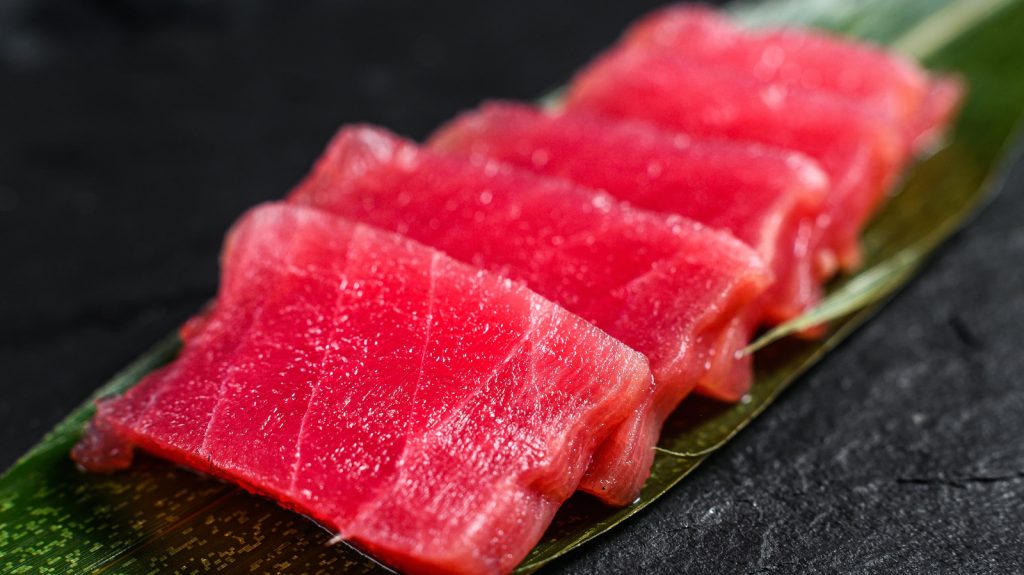
Bluefin tuna, also known as original maguro, is the king of the tuna world and the most popular type. (Source: Internet)
Bluefin tuna is in season in winter and is characterized by its bright red flesh and rich flavor. It is mainly eaten as sashimi and sushi. Bluefin tuna and southern bluefin tuna are the only types of tuna that you can get large fatty tuna.
2. Southern bluefin tuna
Southern bluefin tuna, also known as Indian tuna, is caught in the waters of the South Atlantic Ocean. It is a medium-sized species like bigeye tuna and yellowfin tuna, with a maximum size of about 2.5m.
It is famous as a high-class fish next to bluefin tuna, and it is also a type that can catch large fatty tuna. Southern bluefin tuna is said to be characterized by its sticky, delicious fat, and its dark red meat is rich and sweet.
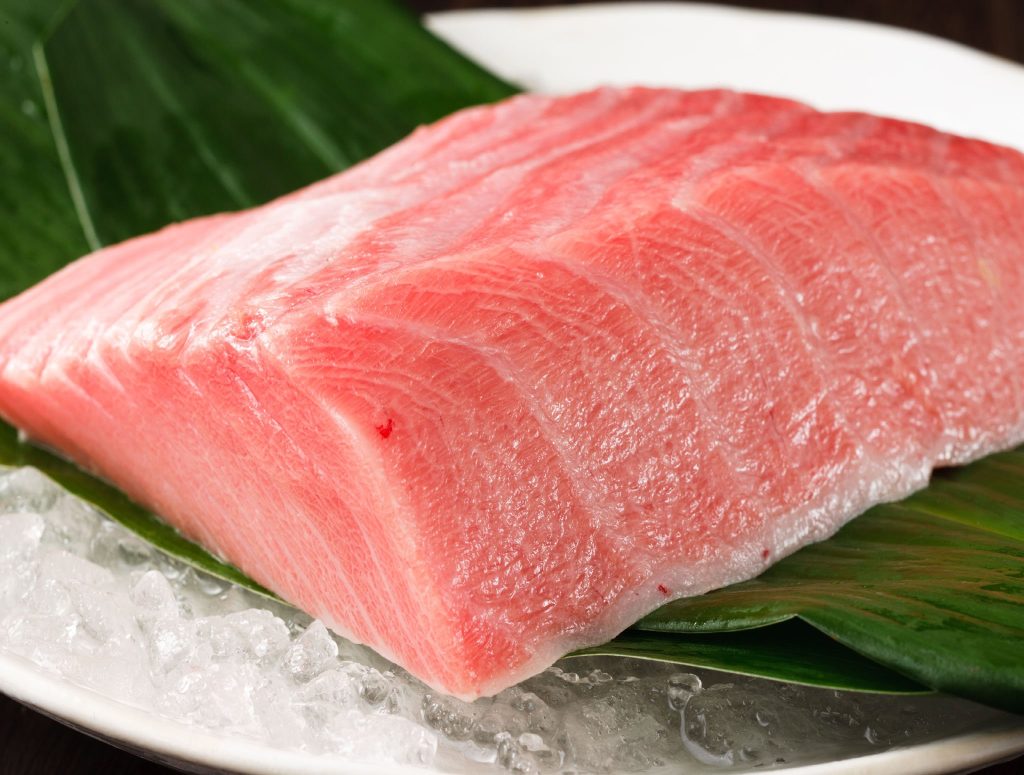
Southern bluefin tuna, also known as Indian tuna, is caught in the waters of the South Atlantic Ocean. (Source: Internet)
The season for southern bluefin tuna, which is often eaten in sashimi and sushi, is in the summer, but in recent years, farming has become popular, so you can enjoy delicious southern bluefin tuna all year round.
You can also like:
- What To Serve With Sushi: The Delectable Side Dish Ideas
- Shabu Shabu and Hot Pot: Exploring the Differences and Delights of Asian Hot Pot Cuisine
- How To Use Zojirushi Rice Cooker For Delicious And Fluffy Rice Every Time
3. Bigeye tuna
The bigeye tuna, also known as the bigeye tuna, is a medium-sized species with a maximum size of 2.5m. Bigeye tuna is caught in warm waters all over the world, and those caught in the waters near Japan are characterized by being slightly smaller.
Bigeye tuna is characterized by its bright pink color and refreshing taste. People in the Kansai region in particular like to eat it, and it is in season from November to February.
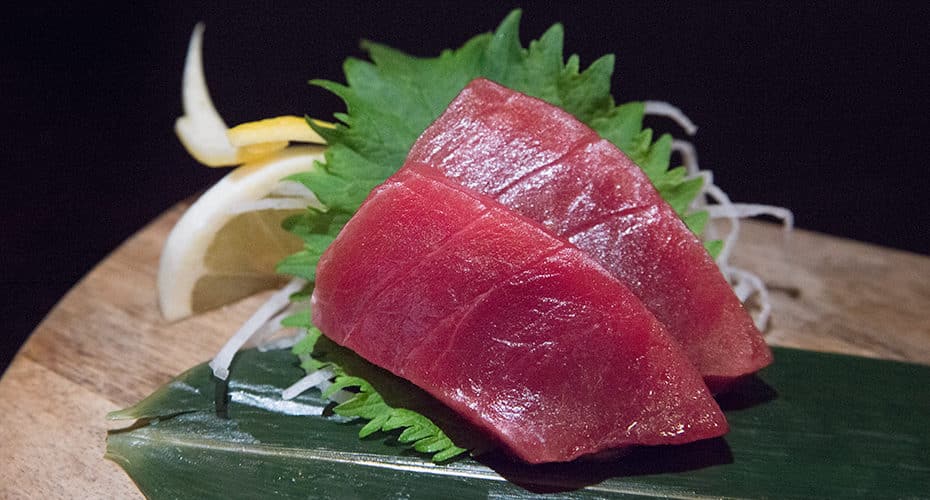
The bigeye tuna, also known as the bigeye tuna, is a medium-sized species with a maximum size of 2.5m. (Source: Internet)
Bigeye tuna has less fat compared to bluefin and southern bluefin tuna, and even the slightest fat has a lot of sinews, so it is not suitable for sashimi. Red meat is often eaten as sashimi or steak.
4. Yellowfin tuna
Yellowfin tuna is written in kanji as “yellow-skinned tuna” and is characterized by its overall yellowish appearance.
Yellowfin tuna is a medium-sized species like southern bluefin tuna and bigeye tuna, but most of the ones caught in the waters around Japan are slightly smaller, measuring up to 1.5m.
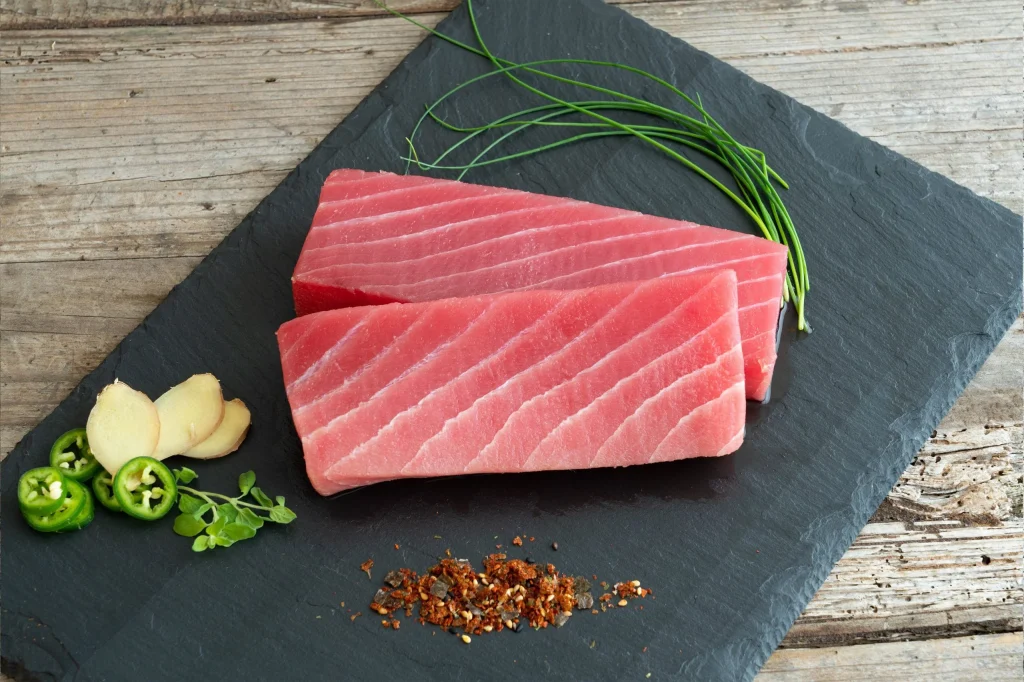
Yellowfin tuna is written in kanji as “yellow-skinned tuna” and is characterized by its overall yellowish appearance. (Source: Internet)
Yellowfin tuna is characterized by its light lean meat and slightly firm flesh. Because of its firm flesh, it retains its shape even when sashimi is prepared, and is often eaten as sashimi or sushi.
Because it is a type with little fat, it is often used as an ingredient for canning.
5. Albacore tuna
Albacore tuna, also known as albacore tuna, is a small species of tuna. Mainly inhabits tropical and temperate waters around the world, with a maximum body length of about 1.5 m, and in Japan, it can be caught only in a small area of Hokkaido.
Albacore tuna is characterized by its soft texture and pink flesh. It has a whitish color overall and is sometimes mistaken for toro because it is called “bintoro” at conveyor belt sushi restaurants, but it is not actually toro.
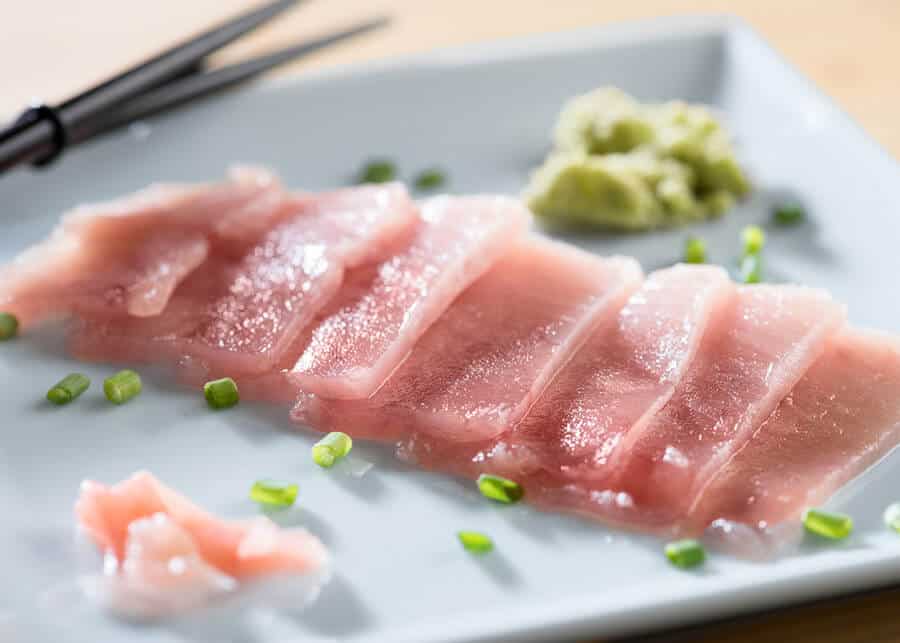
Albacore tuna, also known as albacore tuna, is a small species of tuna. (Source: Internet)
The season for albacore tuna is winter, and it becomes more popular in winter due to its fat content. It is popular as a tuna that can be eaten at reasonable prices at supermarkets and conveyor belt sushi restaurants and is often used as an ingredient in sea chicken.
6. Longtail tuna
Longtail tuna is a small species with a length of about 1m and is a rare tuna that is not shipped in large quantities. It is in season in winter, and the fatty meat is often eaten as sashimi.
However, since they are caught in spring and summer, they are often eaten fried or boiled when they have a light taste. Longtail tuna is a rare species that is rarely seen on the market because it is mainly consumed in the production area.
How to recognize flavorful tuna
For the Japanese, tuna is a well-known food item that is frequently used in sashimi and sushi.
You can simply get tuna at stores where it is marketed as sashimi or fence, but you want to pick good tuna.
This time, I’ll explain how to recognize delectable tuna.
1. Fresh tuna and frozen tuna
Both fresh and frozen tuna are available. In order to preserve freshness, tuna taken in the oceans around Japan is kept in cold water and is often sold in supermarkets one to three days after being caught.
The high level of freshness, silky texture, and robust taste define raw tuna. On the other hand, tuna that is collected in the deep sea is flash-frozen after going through various processes on board, including blood removal.
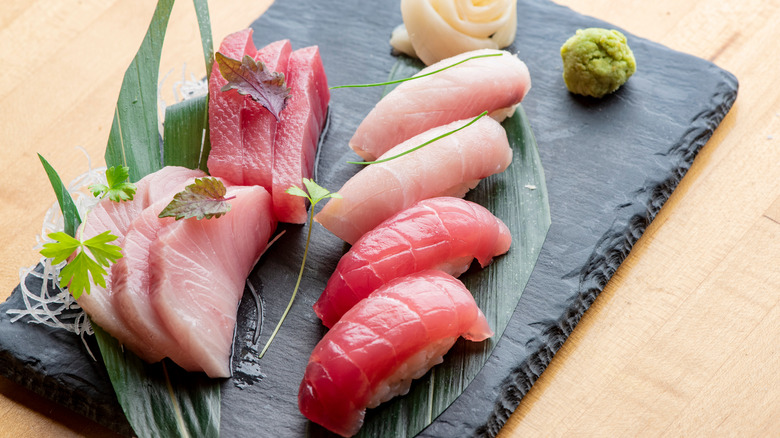
In order to preserve freshness, tuna taken in the oceans around Japan is kept in cold water and is often sold in supermarkets one to three days after being caught. (Source: Internet)
At first look, it could appear that the freshness has decreased because it takes some time for items to be exhibited in supermarkets and other locations.
In recent years, thanks to advances in freezing and thawing technology. It has become possible to enjoy the taste of frozen tuna that is close to that of fresh tuna.
2. Would you like to buy sashimi?
The two primary forms of tuna seen in stores are fence-shaped or ready-to-eat sashimi. The advantage of these is that sushi offered in sashimi form may be consumed right away, which is practical. Additionally, it is frequently offered for a greater price than the fence kind.
4 points to distinguish delicious tuna
When distinguishing delicious tuna, pay attention to the following four points.
- Does it have a bright red color?
- Is the line thin and parallel to the fence?
- Are there any red or black spots?
- Is there red tuna juice in the tray?
When choosing tuna, first choose one that has a bright red or pink color. When tuna loses its freshness, it becomes slightly darker (or whitish).
In addition to the color, the degree of transparency and luster is also a guideline for choosing delicious tuna, so it is a good idea to compare them. When purchasing tuna from a fence, it is best to choose tuna with thin streaks that run parallel (or diagonally) to the fence.
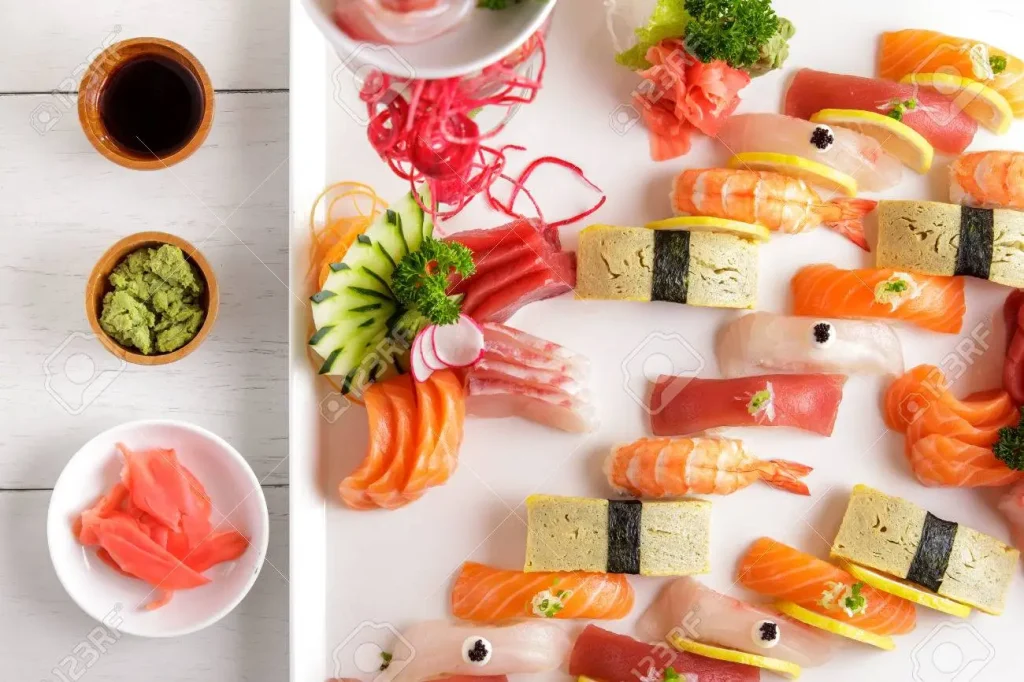
When choosing tuna, first choose one that has a bright red or pink color. (Source: Internet)
When you cut it for sashimi, you can eat delicious sashimi with a good texture because the sinew and the knife are perpendicular to each other. If you don’t have a parallel one, we recommend one that has diagonal streaks against the fence.
Also, avoid choosing tuna with black or red spots as much as possible. This is called a thrombus, and it happens when the tuna is not properly bled. Blood clots can cause a fishy odor and damage, so be sure to observe carefully when purchasing.
Finally, check for red juice in the tray with the tuna. This is called dripping, and it is proof that umami ingredients and nutrients are flowing out when thawing. The more time has passed, the easier it is to drip, and the taste and freshness will decline, so it is better to avoid it when purchasing.
The benefits that Sushi brings to human health
There are many health benefits when you eat sushi:
- Most tuna species have two types of omega-3 fatty acids. It provides heart-healthy nutrients. These omega-3 fatty acids include Omega-3 EPA and Omega-3 DHA.
- The cholesterol from tuna will aid in reducing the amount of fat in your blood. Therefore, it helps to prevent potential cardiovascular-related risks. In addition, it can reduce plaque buildup in a person’s arteries.
- Sushi can play a part in protecting your health from oxidative damage. Moreover, it provides you with your daily intake of selenium. This is a very important nutrient. It takes care of your thyroid and reproductive health.
FAQs
1. Which species of tuna are utilized in sushi?
Shibi or bluefin tuna are other names for bluefin tuna, which is said to be the best quality sushi tuna. This huge tuna has a maximum length of 3 meters and a weight of more than 400 kilograms. It is a tasty tuna with fat and prefers chilly water. 80 to 150 kg is the size that is ideal for sashimi and sushi. The streak is really tasty and thin.
2. What distinguishes yellowfin tuna from yellowfin tuna?
Compared to bigeye tuna, yellowfin tuna is paler and more pink. The raw yellowfin tuna is incredibly fatty and excellent when it is caught in the summer in regions like Wakayama. There is, however, no justification for denying the delectability of yellowfin tuna.
3. Which tuna is served at Kura Sushi?
Wild bluefin tuna was used in the preparation of the “Domestic Natural Bluefin Maguro Toro” (220 yen per piece, tax included below). One of Japan’s top bluefin tuna catches is made here.
4. What sort of tuna is served at Hamazushi?
Only bigeye tuna weighing more than 40 kg is available aboard “Maguro”. It is known as “large bowl tuna” and has a strong umami flavor. To maintain the flavor of the tuna after defrosting, heated salt water that has the same concentration as seawater is employed.
5. What distinguishes bigeye tuna from bigeye tuna?
The bigeye tuna, commonly referred to as the bigeye tuna, is a medium-sized fish that may grow up to 2.5 meters in length. Around the world, bigeye tuna are fished in warm waters; those caught close to Japan are distinguished by being a little bit smaller.
Bigeye tuna is distinguished by its vivid pink color and crisp flavor. It is particularly popular among residents of the Kansai area and is available from November to February.
6. What is a bluefin tuna?
A young bluefin tuna under the age of three, less than 100 cm in length, and weighing approximately 20 kg is called a Meiji tuna. Meiji tuna is the name of it. Due to its youth, the flesh is tender and has a delicate taste. It also has little fat.
7. What kind of fish is Kura Sushi Engawa?
In the case of Kura Sushi, the entrails are mainly those of green flounder and bluefin flounder. It seems that many of them are produced in the United States.
Conclusion
Tuna is a popular ingredient in sushi and is a familiar ingredient to Japanese people. Learn about the types of tuna for sushi that we usually eat casually, and enjoy delicious tuna.








